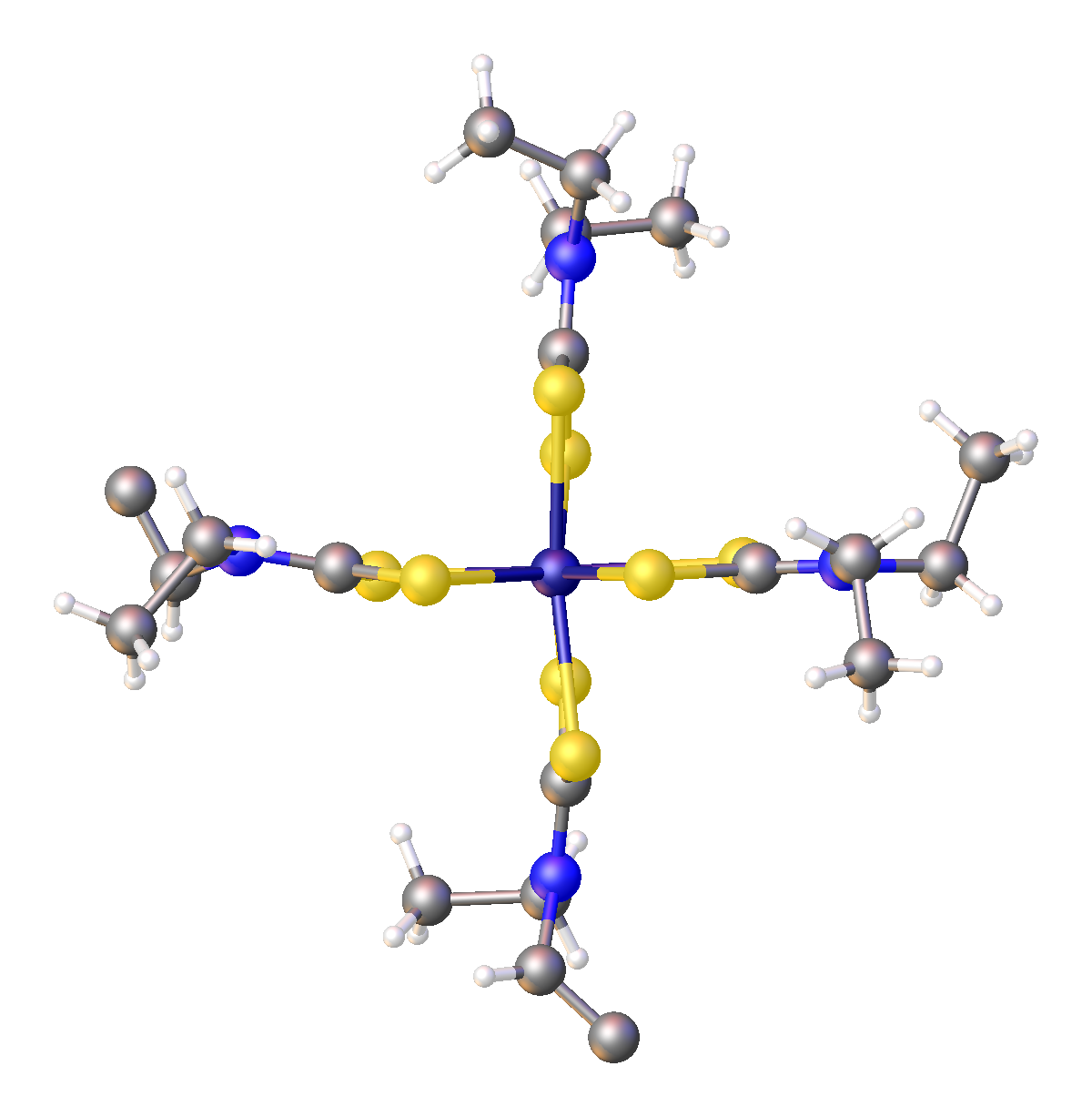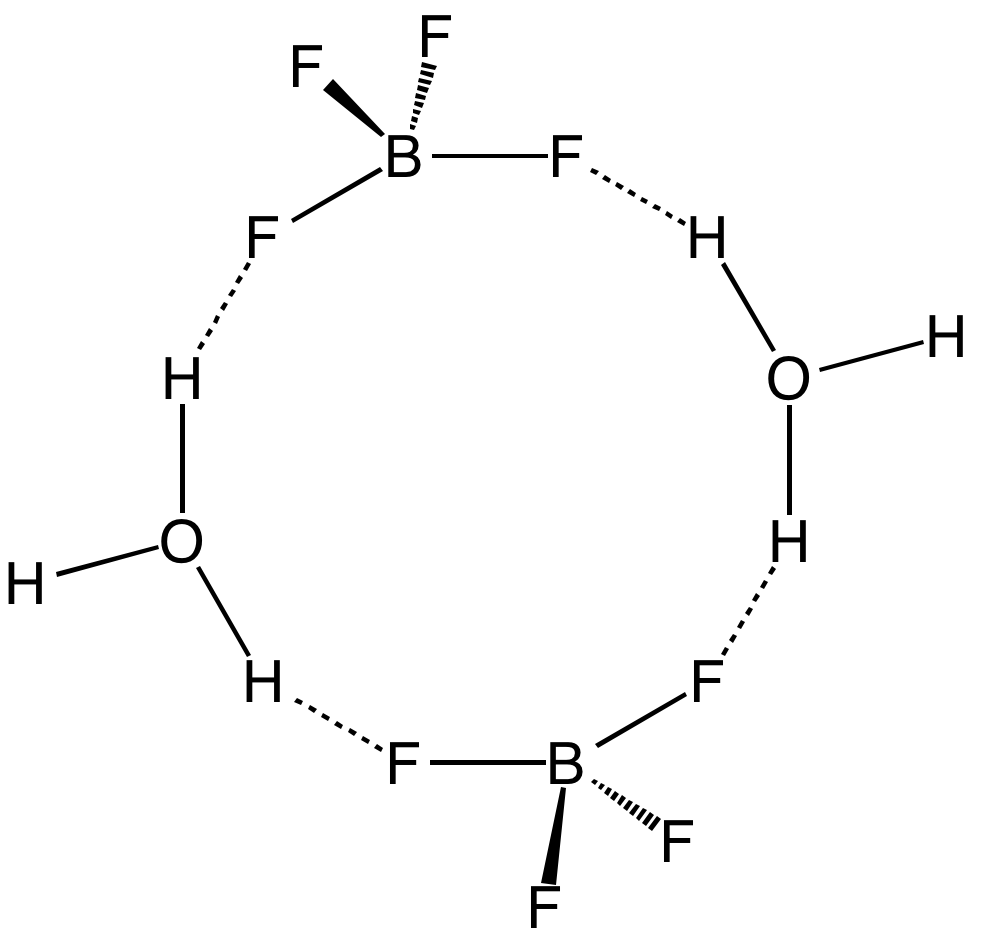|
Cobalt Tris(diethyldithiocarbamate)
Cobalt tris(diethyldithiocarbamate) is the coordination complex of cobalt with diethyldithiocarbamate with the formula Co(S2CNEt2)3 (Et = ethyl). It is a diamagnetic green solid that is soluble in organic solvents. Synthesis, structure, bonding Cobalt tris(dithiocarbamate)s are typically are prepared by air-oxidation of mixtures of dithiocarbamate salts and a cobalt(II) nitrate. Cobalt tris(diethyldithiocarbamate) is an octahedral coordination complex of low-spin Co(III) with idealized D3 symmetry. The Co-S distances are 267 pm. Reactions Oxidation of Co(Et2dtc)3 occurs at mild potentials to give the cobalt(IV) derivative. Treatment of Co(Et2dtc)3 with fluoroboric acid results in the removal of 0.5 equiv of ligand giving a binuclear cation: :2Co(Et2dtc)3 + HBF4 → o2(Et2dtc)5F4 + "Et2NdtcH" See also * Iron tris(diethyldithiocarbamate) Iron tris(diethyldithiocarbamate) is the coordination complex of iron with diethyldithiocarbamate with the formula Fe(S2CNEt2)3 (Et = ... [...More Info...] [...Related Items...] OR: [Wikipedia] [Google] [Baidu] |
Transition Metal Dithiocarbamate Complexes
193px, Structure of iron tris(diethyldithiocarbamate). Transition metal dithiocarbamate complexes are coordination complexes containing one or more dithiocarbamate ligand, which are typically abbreviated R2dtc−. Many complexes are known. Several homoleptic derivatives have the formula M(R2dtc)n where n = 2 and 3. Ligand characteristics Dithiocarbamate anions are bidentate ligands that are classified as L-X ligand in the Covalent bond classification method. In the usual electron counting method, they are three-electron ligands. With respect to HSAB theory, they are classified as soft. Because of the pi-donor properties of the amino substituent, the two sulfur centers show enhanced basicity relative to dithiocarboxylates. This situation is represented by the zwitterionic resonance structure that depicts a positive charge on N and negative charges on both sulfurs. This N to C pi-bonding results in partial double bond character for the C-N bond. Consequently, barriers to ... [...More Info...] [...Related Items...] OR: [Wikipedia] [Google] [Baidu] |
Diethyldithiocarbamate
Sodium diethyldithiocarbamate is the organosulfur compound with the formula . It is a pale yellow, water soluble salt. Preparation Sodium diethyldithiocarbamate typically crystallizes from water as the trihydrate . The anhydrous salt and the trihydrate are often used interchangeably. Sodium diethyldithiocarbamate is obtained by treating carbon disulfide with diethylamine in the presence of sodium hydroxide: :CS2 + HN(C2H5)2 + NaOH → NaS2CN(C2H5)2 + H2O Other dithiocarbamates can be prepared similarly from secondary amines and carbon disulfide. They are used as chelating agents for transition metal ions and as precursors to herbicides and vulcanization reagents. Reactions Oxidation of sodium diethyldithiocarbamate gives the disulfide, also called a thiuram disulfide (Et = ethyl group, ethyl): : Dithiocarbamates are nucleophiles and thus can be alkylated. Even dichloromethane suffices: : Diethyldithiocarbamate reacts with many metal salts to give transition meta ... [...More Info...] [...Related Items...] OR: [Wikipedia] [Google] [Baidu] |
Ethyl Group
In organic chemistry, an ethyl group (abbr. Et) is an alkyl substituent with the formula , derived from ethane (). ''Ethyl'' is used in the International Union of Pure and Applied Chemistry The International Union of Pure and Applied Chemistry (IUPAC ) is an international federation of National Adhering Organizations working for the advancement of the chemical sciences, especially by developing nomenclature and terminology. It is ...'s nomenclature of organic chemistry for a saturated two-carbon moiety in a molecule, while the prefix "''eth-''" is used to indicate the presence of two carbon atoms in the molecule. Ethylation Ethylation is the formation of a compound by introduction of the ethyl group. The most widely practiced example of this reaction is the ethylation of benzene with ethylene to yield ethylbenzene, a precursor to styrene, which is a precursor to polystyrene. Approximately 24.7 million tons of ethylbenzene were produced in 1999. :: Many ethyl ... [...More Info...] [...Related Items...] OR: [Wikipedia] [Google] [Baidu] |
Coordination Complex
A coordination complex is a chemical compound consisting of a central atom or ion, which is usually metallic and is called the ''coordination centre'', and a surrounding array of chemical bond, bound molecules or ions, that are in turn known as ''ligands'' or complexing agents. Many metal-containing chemical compound, compounds, especially those that include transition metals (elements like titanium that belong to the periodic table's d-block), are coordination complexes. Nomenclature and terminology Coordination complexes are so pervasive that their structures and reactions are described in many ways, sometimes confusingly. The atom within a ligand that is bonded to the central metal atom or ion is called the donor atom. In a typical complex, a metal ion is bonded to several donor atoms, which can be the same or different. A Ligand#Polydentate and polyhapto ligand motifs and nomenclature, polydentate (multiple bonded) ligand is a molecule or ion that bonds to the central atom ... [...More Info...] [...Related Items...] OR: [Wikipedia] [Google] [Baidu] |
Symmetry Group
In group theory, the symmetry group of a geometric object is the group of all transformations under which the object is invariant, endowed with the group operation of composition. Such a transformation is an invertible mapping of the ambient space which takes the object to itself, and which preserves all the relevant structure of the object. A frequent notation for the symmetry group of an object ''X'' is ''G'' = Sym(''X''). For an object in a metric space, its symmetries form a subgroup of the isometry group of the ambient space. This article mainly considers symmetry groups in Euclidean geometry, but the concept may also be studied for more general types of geometric structure. Introduction We consider the "objects" possessing symmetry to be geometric figures, images, and patterns, such as a wallpaper pattern. For symmetry of physical objects, one may also take their physical composition as part of the pattern. (A pattern may be specified formally as a scalar field, ... [...More Info...] [...Related Items...] OR: [Wikipedia] [Google] [Baidu] |
Fluoroboric Acid
Fluoroboric acid or tetrafluoroboric acid (archaically, fluoboric acid) is an inorganic compound with the simplified chemical formula . Solvent-free tetrafluoroboric acid () has not been reported. The term "fluoroboric acid" usually refers to a range of compounds including hydronium tetrafluoroborate (), which are available as solutions. The ethyl ether solvate is also commercially available, where the fluoroboric acid can be represented by the formula , where ''n'' is 2. It is mainly produced as a precursor to other fluoroborate salts.Gregory K. Friestad, Bruce P. Branchaud "Tetrafluoroboric Acid" E-Eros Encyclopedia of Reagents for Organic Synthesis. It is a strong acid. Fluoroboric acid is corrosive and attacks the skin. It is available commercially as a solution in water and other solvents such as diethyl ether. It is a strong acid with a weakly coordinating, non-oxidizing conjugate base. It is structurally similar to perchloric acid, but lacks the hazards associated with ox ... [...More Info...] [...Related Items...] OR: [Wikipedia] [Google] [Baidu] |
Iron Tris(diethyldithiocarbamate)
Iron tris(diethyldithiocarbamate) is the coordination complex of iron with diethyldithiocarbamate with the formula Fe(S2CNEt2)3 (Et = ethyl). It is a black solid that is soluble in organic solvents. Synthesis, structure, bonding Iron tris(dithiocarbamate)s are typically are prepared by salt metathesis reactions. Iron tris(diethyldithiocarbamate) is an octahedral coordination complex of iron(III) with idealized D3 symmetry. The phenomenon of spin crossover (SCO) was first reported in 1931 by Cambi ''et al.'' who observed anomalous magnetic behavior for the tris(N,N-dialkyldithiocarbamatoiron(III) complexes. The magnetism of these complexes are sensitive to the nature of the amine substituents as well as to temperature. This behavior is consistent with an equilibrium between two or more spin states. In the case of Fe(Et2dtc)3, X-ray crystallography reveals that the Fe-S bonds are 231 pm at 79K but 356 pm at 297 K. These data indicate a low-spin configuration at low temperatures a ... [...More Info...] [...Related Items...] OR: [Wikipedia] [Google] [Baidu] |
Dithiocarbamates
In organic chemistry, a dithiocarbamate is a chemical compound with the general formula . It contains the functional group with the Chemical structure, structure . It is the analog of a carbamate in which both oxygen atoms are replaced by sulfur atoms (when only one oxygen is replaced the result is thiocarbamate). Dithiocarbamate also refers to the dithiocarbamate ion and its salts. A common example is sodium diethyldithiocarbamate . Dithiocarbamates and their derivatives are widely used in the vulcanization of rubber. Formation Many secondary amines react with carbon disulfide and sodium hydroxide to form dithiocarbamate salts: : Ammonia reacts with carbon disulfide, similarly, to give ammonium dithiocarbamate: : Dithiocarbamate salts are pale colored solids that are soluble in water and Solvent, polar organic solvents. Dithiocarbamic acid A primary amine and carbon disulfide react to give a dithiocarbamic acid: : In the presence of diimides or pyridine, these acids convert t ... [...More Info...] [...Related Items...] OR: [Wikipedia] [Google] [Baidu] |



